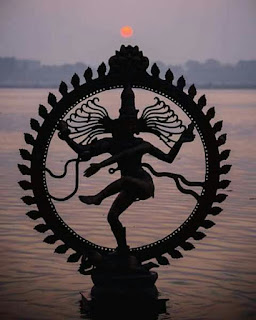According to Hinduism, life and the various
species originated by the planetary globes and the five manifestations of
nature, namely – Earth, Water, Fire, Air, and Ether. ‘Bhoota’ is Sanskrit means
‘compound’ and ‘Maha Bhoota’ indicates ‘big compound’.
‘Panch Bhoota Sthalam’ where ‘Pancha’ means
five, Bhoota’ means elements, and ‘Sthalam’ means place, refers to the five beautiful temples located in South India. Out of these five temples, four are in Tamil
Nadu and one is in Andhra Pradesh. These temples are dedicated to Lord Shiva,
who is worshipped in South India as the presiding deity of the ‘five elements’
of nature and is called Bhootpati or Bhootnath. He is the upholder of the five
elements which are the building blocks of everything in creation, including the
human being.
In honour of the aspect that ‘not even a blade of grass can move without the permission of Lord Shiva’ who upholds the five
elements are the Panch Bhoota Sthalams- the five Shiva temples, each of which represents one
of the five elements of nature. Here is a small attempt to take you to these:
1.
Ekambareswar Temple:
One among the Panch Bhoota Sthalams, located in Kanchipuram, Tamil Nadu, it is one of the most sacred Shiva temples. The temple is represented by the lingam and His idol is referred to as ‘Prithvi lingam’ as this temple represents the element Earth. The temple has one of the tallest temple towers in India, covers an area of 25 acres, and is one of the largest in India. It houses many halls and the most notable is the one thousand pillared hall. The presiding deity is Shiva, who is known here as Ekambareswarar.
2.
Jambukeswar Temple:

This temple in Tiruchirappalli, Tamil Nadu,
one of the Panch Bhoota Sthalams is dedicated to Lord Shiva and Goddess Parvati.
Legend has it that Shiva asked Parvati to go to earth to perform her penance.
Parvati found Jambu forest to conduct her penance. Hence, she made a lingam out of the water of River Cauvery
and commenced her worship. Therefore the lingam is called ‘Appu lingam’ or the ‘Water
lingam’. Lord Shiva is worshipped here as Jambukeshwar and Goddess Parvati
as Akhilandeshwari. There are five enclosures in the temple. The massive wall
covering the fifth precinct stretches over a mile is 2 feet thick and is around
25 feet high. It is said the wall was built by Lord Shiva working with the
labourers.
3.
Arunachaleswar Temple:

The temple lies in the town
of Tiruvannamalai in Tamil Nadu. The Shiva lingam here represents the element
Agni (Fire). The temple believed to be one of the largest is said to be ‘truly
the holy place’ of all the holy places. Shiva is worshipped here as Arunachaleswar
or Annamalaiyar, and is represented by the lingam, with His idol referred to as
‘Agni lingam’. It is believed to be the most sacred as this place Arunachala is
Lord Shiva Himself as Shiva Shiva appeared here in the form of Ardhnarishwar to bless His devotees.
4.
Sri Kalahastiswar Temple:

The temple is the most famous
Shiva temple in the Chittoor district of Andhra Pradesh. The Shiva linga here
represents the element Vayu (Air). Built in the 5th century, Shiva in His
aspect of Vayu is worshipped here as Kalahasteeswara and Goddess Parvati as
Gnanaprasunambica. It is one of the most ancient and historical ancient temples
(2000 years or more). The temple is also regarded as ‘ Rahu- Ketu kshetra’ and ‘Dakshina
Kailasam’ (Kailas of South).
5. Thillai Natraja Temple:

Also referred to as the
Chidambaram Natraja Temple, this temple located in the Chidambaram city of Tamil
Nadu is a Hindu temple dedicated to Lord
Natraja (a form of Lord Shiva) - the Lord of Dance. The temple is also referred
to as ‘Akasasthalam’ as the Shiva linga here represents element Akasha (Sky). It is one
of the oldest surviving and active temple complexes in India. Shiva Himself is
presented as Natraja performing the ‘ Anand Natya’ or the ‘Dance of Delight’
and the linga is known as Aagaya lingam or the Akasha lingam.

Follow me on : speakingtree, medium, facebook, Linkedin, Upwork, Fiverr,Peppercontent



Comments
Post a Comment